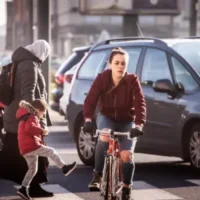The plane that took thermal photos on Tuesday evening was commissioned by three Brussels municipalities. “On the basis of different colors, people will be able to see exactly where the heat leaves their house,” says alderman Antoine Bertrand (Ecolo) from Woluwe-Saint-Pierre. The results will be available in the form of a map in the spring.
For three hours on Tuesday evening, a Cessna sports plane with an infrared camera flew around above the City of Brussels, Auderghem and Sint-Pieters-Woluwe. The aircraft had taken off near Geraardsbergen around 9.30 pm and then flew back and forth over Brussels for hours. The pilot did this to be able to take thermal photos of the buildings and to see which buildings could be better insulated.
“As a government, we felt it was our duty in these times of energy crisis to provide our residents with information about the insulation of their homes,” said Antoine Bertrand (Ecolo), alderman for Energy in Woluwe-Saint-Pierre. The measurement is being carried out at the request of the municipalities of Woluwe-Saint-Pierre, Auderghem and the City of Brussels. Not a regional initiative, therefore, Brussels Environment was not involved in the initiative.
Many inhabitants of Brussels noticed the plane, but in Sint-Pieters-Woluwe the inhabitants were already aware of it. There, the municipality had even recommended leaving the heating on in the night from Tuesday to Wednesday, so that any heat loss due to the measurements could be mapped.
“It all sounds a bit paradoxical: letting an airplane fly over for hours and asking people to leave their heating on, but the map is a useful tool to see which buildings can be better insulated,” says Bertrand.
Detailed Map
“The results will be available in the form of a map from spring,” he explains. “A bit comparable to the solar map of the Brussels region.” This map from Brussels Environment indicates the solar potential of a roof, in order to estimate the costs and benefits of solar panels. Although the plane has collected data for the entire Brussels region, the map will only show the three municipalities involved. “The company behind the images may sell the data to other Brussels municipalities,” says Els Wauters, spokeswoman for Brussels ships of Climate Benoit Hellings (Ecolo).
Owners can also request a zoomed-in photo of their home via a software program that the three municipalities will be launching by spring. “The images are accurate to within 40 centimetres,” says Bertrand. “On the basis of different colours, people will be able to see exactly where the heat leaves their house.”
“It will also come in handy for architects or contractors during renovation work,” Bertrand continues. “For example, they will be able to see exactly which skylight needs to be replaced or which part of a roof is insufficiently insulated.”
The data will be made available free of charge to anyone who requests it. “Those who prefer not to have their house visible on the map can always submit a request to blur the house,” says alderman Bertrand.
“It is certainly not the intention to impose an insulation obligation on owners on the basis of the collected data,” said the ships. “That is also not possible: during the measurement, not all houses were necessarily heated, which makes it difficult to make statements about how well insulated those houses are.”
This article is originally published on .bruzz.be



